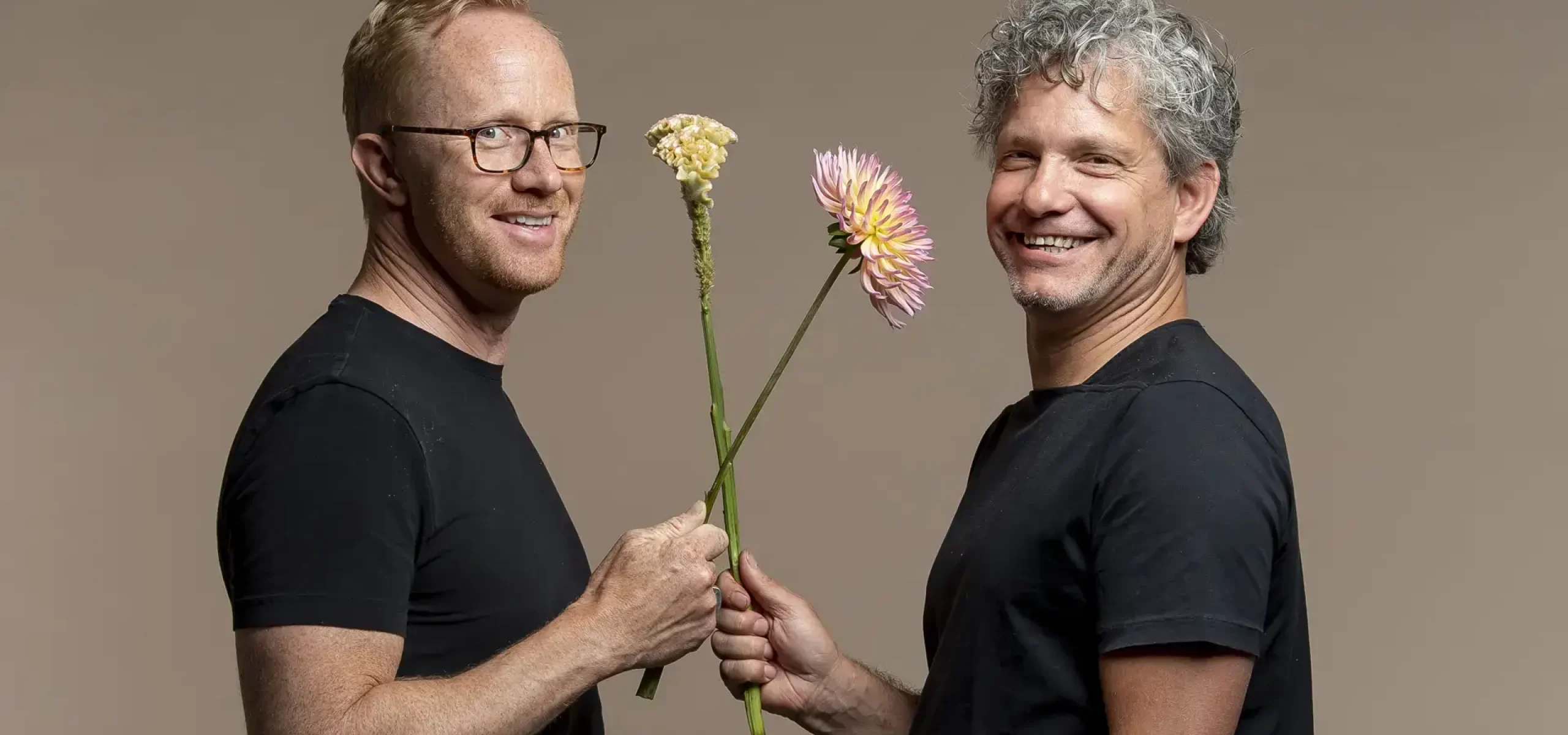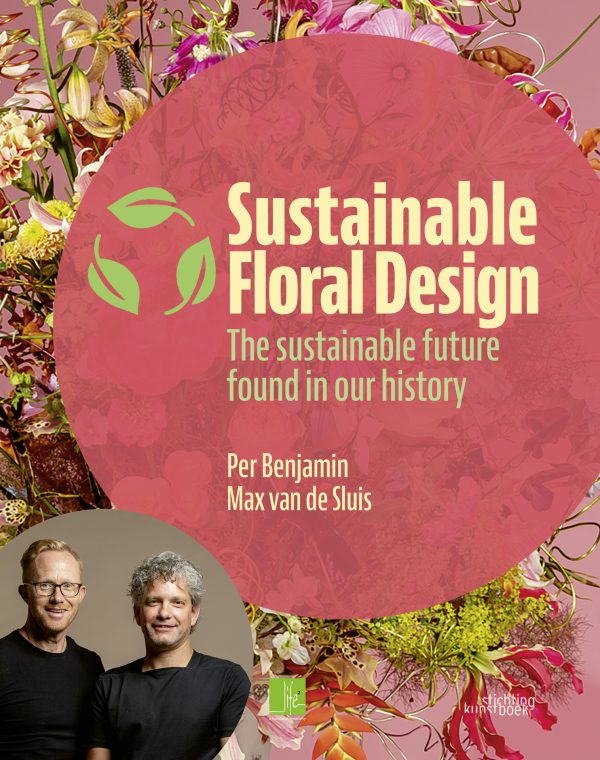
When you become aware of sustainability, you can't unsee it. 'Once you start realising the impact of your materials, it really opens your eyes,' says floral designer Max van de Sluis. 'Suddenly you think: What are we actually using?' This awareness has profoundly changed his approach to floral art.
Together with Swedish floral designer Per Benjamin, Max recently published the book Sustainable Floral Design. 'We felt an urgency. We can't close our eyes to the impact our profession, craft, and designs have on this planet,' he says. 'We wanted to take the first steps toward a more sustainable world. But it's a journey we must build together with the whole industry.'
Max and Per's journey begins far back in history. 'In the book we go right back to the Stone Age, passing through Ancient Egypt, Greece, and Rome up to the present day. The fascinating thing is seeing that many techniques and materials used historically were natural, reusable, or compostable. In fact, we had a smaller footprint centuries ago.'
Regarding the sustainability special in this World Cup edition of DPK Floral Magazine, how did he make sustainable choices for these floral works? You aim to present flowers with as minimal a footprint as possible, or preferably none at all. Either you use reusable materials or compostable ones. You look for smarter ways to work without plastics, petroleum products, or other harmful materials.'
'Sustainability isn't a step back; it's a step forward. It's not limiting. On the contrary, it opens doors, and I find it incredibly inspiring because you must think differently about your materials.' Reflecting on his past work, Max openly acknowledges his personal shift: 'Years ago, I created stunning floral designs in Japan, full of vibrant plastic materials. The photographs were beautiful - but today, I wouldn't choose those materials anymore.'
Immediate approach
Max and Per highlight practical approaches that professionals can take immediately. 'A bouquet is an excellent sustainable medium. If you bind your bouquet with compostable string, you're already making a difference. People simply want flowers, and bouquets are ideally suited to sustainable design.'
They mention the rediscovery of traditional tools like kenzans - metal pin holders traditionally used in Japanese floral arranging. 'You can create wonderful designs with kenzans and similar reusable frameworks. They're versatile and reusable, which significantly reduces the environmental footprint over time.'
Some practical alternatives blend aesthetics with sustainability. 'I've rediscovered clay and branches for bases and framework. Filling vases with hollow bamboo pieces creates natural supports for flowers. Or if you have a thick wooden disc or plate, you can drill holes into it, place it over a vase or bowl filled with water, and stick the flowers through the holes in the water. The flowers will then stay upright, and it's both decorative and durable.'
'What I want is for the solutions to play a decorative role in the overall arrangement. In the floral pieces I've made in this special, I rolled up and tied Ficus leaves, and then inserted flowers into them. For another arrangement, I made a net from roadside grasses and placed the flowers through it into the water. But grouping little, or big, vases also work well. They're all reusable solutions with a small footprint.'
Seasonal flowers
Seasonality particularly resonates: 'I've always loved seasonal flowers. Historically, that's how we worked. After Christmas, for example, you'd have only lilacs and irises to work with. It forced creativity. Now we're going back to appreciating that purity and simplicity.'
But what about the flowers themselves? They believe the challenge is largely in the messaging: 'Communication is the key issue. The flower industry is fragmented and, unlike large corporations, lacks the budget to effectively communicate its story. A lot of great work is happening, but nobody knows about it. Misconceptions persist.'
There's room for improvement, although Max already sees many good examples. Breeders' associations like Marginpar and Decorum Company are genuinely making efforts towards sustainability. There's movement away from heavy pesticide use. Perhaps we should accept some natural imperfections like insect damage in flowers, rather than insisting on perfection that demands harmful chemicals.'
Gradual change is essential. Sustainability must grow step by step. You don't have to shift entirely from black to white overnight. Small changes matter, like choosing paper instead of plastic wrapping, or seasonal flowers which naturally have a lower footprint.'
Collective action
'Sustainability demands collective action - from florists and growers to suppliers. The entire industry must evolve together. Change is challenging, both technically and aesthetically, but we florists are known for solving complex problems. We can tackle this one too.' And consumers? 'They're increasingly interested in sustainable choices. In some urban areas, buying flowers has become almost 'taboo' due to sustainability concerns. So, we need to communicate clearly and educate the market.'
'Everything we do affects something else,' Max reflects. 'Take Sphagnum moss. It's compostable, yes, but harvesting it damages permafrost ecosystems. So, sustainability isn't always straightforward. It's crucial to remain aware of these nuances.'
For Per and Max, sustainability in floral art is intrinsically linked with creativity. 'When you limit your material options, you're compelled to innovate. This isn't restrictive - it's liberating. Creating something new always gives more energy and positivity than repeating the old.'
Ultimately, Per and Max's message is positive and collaborative, they believe historical knowledge holds the key. 'Our sustainable future lies within our very own history. We don't have to reinvent everything - just rediscover and adapt. It's a creative challenge, driven by curiosity and optimism. And a process of sharing, experimenting, and learning. If we implement these changes now, we'll not only preserve our profession but also make the world a little more beautiful.'

Sustainable Floral Design
The sustainable future found in our history
Per Benjamin, Max van de Sluis
'The book is twofold. On the one hand, it covers the history of floral art and,
on the other, uses historical insights to explore solutions for the future'
Max van de Sluis.
Art Book Foundation
ISBN 978-90-5856-709-3
Want to order the book?
Send an email to maxvandesluis@gmail.com
The price: € 65 plus shipping costs